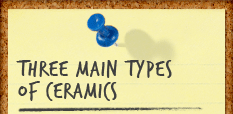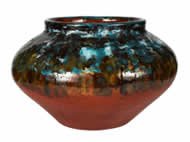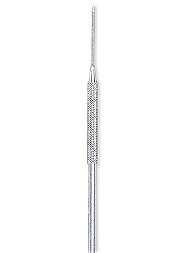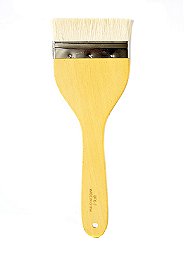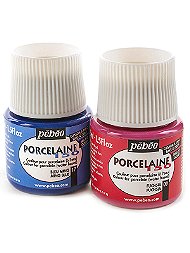Purchase Guide: Ceramics
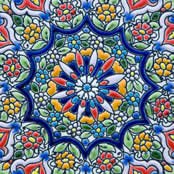 Buying Ceramics Online
Buying Ceramics Online
One of the oldest and most popular art forms in the world, ceramics encompasses all art created from clay
bodies and fired at high temperatures into a rigid, ceramic form. Ceramics is a very versatile medium; nearly
any three-dimensional object can be formed and fired in clay. Some ceramic pieces are intended as fine art,
enjoyed purely for their aesthetic value, while other, more functional pieces fall more easily into one of the
decorative, industrial, or applied arts.
Historically, the creation of ceramics has involved shaping a body of mineral-rich clay into beautiful or
functional designs and baking them inside a kiln. Ceramic art made in this fashion has an extensive history,
with some of the best known and beautiful examples of the art form stemming from ancient Chinese, Cretan, Greek,
Roman, Persian, and Mayan artists. Ceramics has evolved a great deal since then, in both artistry and materials.
Today, ceramic art is produced from a wide variety of materials, some of which contain no clay at all!
The fact that even primitive peoples were adept at ceramics proves that you don't have to buy a lot of
expensive tools to work in the medium. The best tools for ceramics are simple shapes you can use to carve, trim,
and form clay. MisterArt.com features everyday discounts on tools, clay, and everything you need to create ceramic art!
This buyer's guide is designed to help you to quickly and easily find the perfect art supplies for your
ceramics project.
Clay
Clay has properties making it ideal for use in creating sculpture and pottery that
have been exploited by cultures all over the world since the dawn of civilization. Clay becomes plastic when
wet, which makes it easy to form and shape. As it dries up, clay firms and hardens, allowing the artwork to be
handled without being damaged. After being fired in high temperatures, clay is converted into a ceramic
material, making the clay object's shape permanent.
Different clays containing different mixtures of minerals that are subjected to different firing conditions
produce the three main different types of ceramics:
- earthenware,
- stoneware, and
- porcelain.
Many modern ceramicists also use polymer or artificial clays. Oftentimes these modern materials exhibit
properties not found in natural clay, and some do not require firing. You can find discounts on all of these clays at MisterArt.com.
Cones
Cones are tools used in kilns during the process of firing ceramics that
indicate that the kiln has reached a certain temperature. The cones, often used in sets, are placed inside of
the kiln alongside the wares being fired and melt and soften when the kiln reaches a certain temperature. This
way, they provide a visual reference of when the ceramics being fired have reached maturity and fully hardened,
a process that requires varying degrees of time and heat.
Because it takes different ceramic objects different amounts of time and heat to mature, cones are manufactured
to wilt at a variety of temperatures, as well. A universal number system has been established which indicates
how fast and hot a cone will melt. The coolest cones are numbered 022 and the hottest cones bear the number 42.
Observation of the cones is used to determine when a kiln has reached a desired temperature. Some cones can
even be arranged to trigger kiln controls, shutting the kiln off once it has reached or exceeded the necessary
level of heat.
MisterArt.com supplies many different cones discounted every day!
Stilts
When ceramic works are being fired, kilns are packed using shelves and supports. As the kiln is packed for
glaze firing, it's important to remember that the works shouldn't touch one another—the glaze can cause
them to stick together. Glaze that drips from ceramic pieces on to the kiln shelves can also bond the piece to
the kiln, which can make the artwork impossible to remove without damaging or destroying it. The best way to
prevent this problem is by coating shelves with kiln wash and by
using stilts, which elevate ceramic art out of direct contact with the
shelf.
Most stilts feature small metal points on which the artwork rests during firing. These points can sometimes
leave small marks on the work which will need to be ground down. The most common, multi-purpose stilts are tri-
and quadrangular star stilts, which feature three or four points for your ceramic art to rest upon. There are
all kinds of specialized stilts, though, that are designed to hold everything from vases to ladles to box lids
and more during firing. MisterArt.com offers fast delivery on stilts suited
to many different kinds of ceramics projects.
Glaze and Under-Glaze
After being fired, clay produces a variety of lovely and neutral tones that can really aid in bringing out
certain pieces' character. Other works of art, however, call for bold colors, pretty patterns, or pleasant
textures. Additionally, a finishing coating is necessary for earthenware vessels, which would otherwise be
unable to hold liquids due to their porosity.
In these cases, glaze can be applied to ceramics. Glaze functions as
both a sealant as well as a surface decoration. Glazes comprise glass-forming materials with added ingredients
that determine the melting temperature and finished quality of the glaze, including gloss, matte, and color. Not
unlike a cake mix that begins as a pale, unappetizing paste before being transformed into a golden sponge when
baked, glaze mix rarely gives an accurate indication of its final fired color. It's always a good idea to fire a
few test samples of a new glaze to get a better idea of what the finished piece will look like before applying
it to valued artwork.
Decoration that is applied to ceramics under the final layer of glaze is known as under glaze. Typically, under glazes include opaque colors that are
then finished by a final layer of wet glaze to complete the piece.
There are innumerable types of decorative glazes for ceramics, enough
to satisfy artistic demands for both pottery and sculpture. You can find a great discounted selection at
MisterArt.com.
Tools
Since the art of ceramics began in ancient cultures, artists have used both simple and sophisticated tools to help simplify and improve their sculpture and potting. Some of the best
tools that can be used to shape ceramics are common household items, including files, hammers, nails, and other
objects that can be manipulated to smooth, form, or imprint clay. However, in the millennia since ceramics were
invented, a few specialized tools have been developed that are especially useful in working with clay and
glazes.
Specialized tools used in the creation of ceramics include tools to cut and separate clay, tools to trim and
sculpt sculptures, wheels to maneuver and spin pottery and figurines, pads and files to smooth fired pieces,
even highly specialized tools such as wands to smooth the eye sockets of porcelain dolls to prepare them for the
insertion of glass eyes. No matter what tool your project requires, you'll find
the best price and quickest delivery by shopping at MisterArt.com.
Brushes
Brushes are an essential tool for applying most glazes. Longer, soft mop-like
brushes are ideal for slapping on glazes; smaller, finer brushes are typically better for tiny details and under
glazes. Brushes are also useful for cleaning away bits of clay as you carve or cut large pieces. Some brushes
are highly specialized, such as brushes designed for stippling patterns or pin striping. Many of the brushes
suited for glazing and other ceramics work are inordinately similar to paintbrushes. You can find them at
MisterArt.com.
Books and Media
Not sure how to get started with ceramics? Wondering how to get your work to the next level? MisterArt.com
carries several beautiful and informative books and other media on the
subject that illustrate techniques and examples to inspire the work of ceramicists old and new. Whether you're
looking to try a new form or simply add a few new skills to your repertoire, MisterArt.com can help you read to
achieve!





